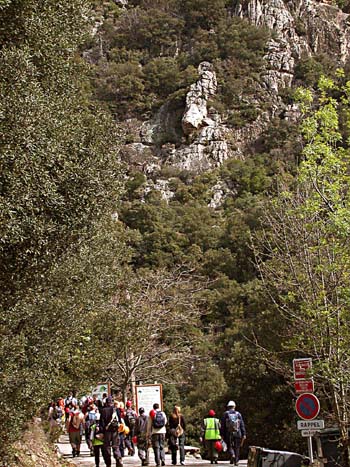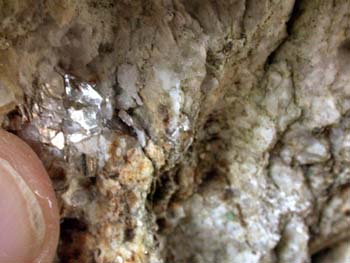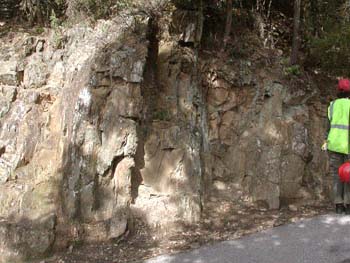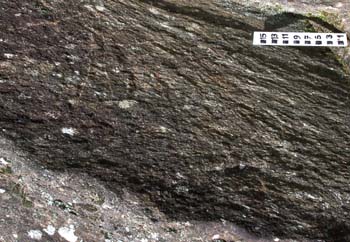|
|
|
The rocks: composition
On the left hand side of the road
going upwards the rocks are well exposed. They are grey-brown-ochre-buff,
relatively hard, consist largely of silicate minerals and are equigranular
with medium-fine sized grains. Grains have relatively regular crystal
shapes.
|

|
|
View up the road which is our route (click
for a larger image)
|
| |
Uplift of the rocks
of the Caroux Massif
Subsequent uplift has brought the rocks back to the surface and lifted
them to above the surrounding land. The rocks now form a large domed
shaped structure which is the Montagne Noire of which the
Caroux Massif is the south eastern corner. The origin of this structure
is discussed in the Geology section.
We are now in the outer skin of the structure. |
| |
The formation of the
Gorges d'Héric
The gorge we are moving into was formed by the fast moving river,
the Ruisseau d'Héric. As the rocks were progressively uplifted,
the river cut relatively deeper into the rock layers. |
| |
 |
|
 |
| The well exposed rock at location
1 showing the upright orientation |
| |
Structures
Cleaved surfaces reveal a steeply dipping lineation which a close
look reveals to be minor folds 1 cm x 4 cm, evidence of a foliation
(an orientation of any elongated or flattened crystals in a plane
perpendicular to the forces acting on a rock) the orientation of which
has a strike (horizontal component) of E78 degrees N and a dip (vertical
component) of 80 degrees to the south. |
| |
Metamorphic change
The rock here is a low grade metamorphic
psammite.. Medium sandstones became buried by a km or two and subjected
to fairly high pressures and temperatures causing a modest (in this
case) change in texture (this change to the texture and balance of
minerals in rocks due to the influence of the long term high pressures
and temperatures deep underground is called metamorphism). |
| |
 |
| Close up of the texture of the
schist. The microfolds are evident, but are they regular enough to
be called crenulations? |
| |
Light coloured veins
in the rock
There are veins 2 - 10 cm of a much coarser mottled white and grey
rock with well formed (euhedral) crystals up to 2-3 cm across. These
minerals are transparent grey crystalline quartz (the silica rich
mineral of which sand is usually composed (50%), white feldspar (a
crystalline mineral of mainly silica, oxygen, aluminium and hydrogen.(35%),
Biotite, a dark blackish brown form of mica(10%). This rock is a particularly
coarse form of granite known as pegmatite. These veins
were created by the injection of molten magma into cracks which may
have formed as a result of a stretching of the brittle metamorphic
rocks. |
|
